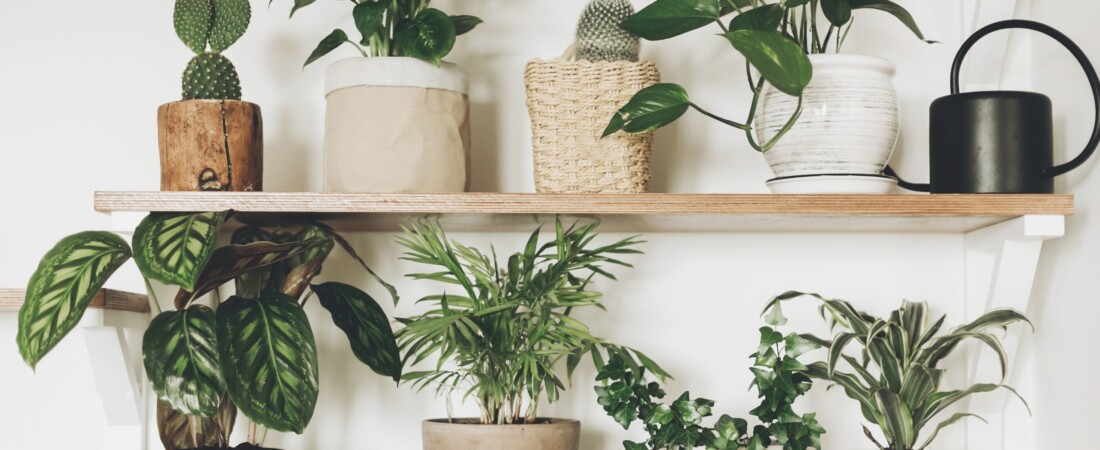From January blues to an ongoing pandemic, it’s likely we all need a little mood boost. The good news is that there’s something we can introduce to our home, a place we are all spending plenty of time at lately, to help with this.
Houseplants! We depend on plants hugely – they are not only the lungs of the planet, but they are responsible for the air we breathe and the food we eat. As well as this, they have an extraordinary range of properties, from the healing powers of the Aloe Vera to the air purifying qualities of the Peace Lily. So, we’ve put together a list of our four favourite plants that will love you back.
Spider Plant
A staple in every 1970s household, the spider plant is one of the easiest to look after. It can survive in most indoor spaces, making it perfect for beginners. Spider plants have been found to remove 95% of formaldehyde in the air, as well as improving oxygen levels and removing carbon dioxide and nitrogen dioxide. They are perfect placed on a shelf or macrame hanger, as they will eventually send out flowering shoots that grow baby spiders.
Peace Lily
The plant for a good night’s sleep, the peace lily works hard to remove chemicals from the atmosphere. In addition, it is capable or removing airborne mould and in turn alleviating allergy and asthma symptoms. The peace lily blooms reliably with glossy foliage and white flowers if watered once or twice a week and placed in indirect sunlight. This one will droop if in desperate need of hydration but will transform before your eyes once watered.
Aloe Vera
The aloe vera is a rich source of antioxidants and vitamins, including vitamin A, C, and E. The succulent is well-known for supporting skin hydration and clarity, and is found in many products, from mascara to moisturiser. The plant’s spiky leaves produce a gel which is easy to extract, and has been used historically to improve dry skin, burns and acne. The aloe plant requires bright, indirect sunlight and its soil should be left to dry in between watering.
Snake Plant
Considered to be queen of air cleaners, the snake plant is both robust and refreshing. Commonly referred to as ‘mother-in-law’s tongue’, the snake plant is virtually bulletproof with the ability to absorb excessive amounts of carbon monoxide and filter toxins such as benzene, xylene, trichloroethylene and formaldehyde. Something particularly unique about the snake plant is that it can convert carbon dioxide into oxygen at night, making it ideal for regulating healthy airflow in the bedroom. The snake plant thrives in a warm, light spot without overwatering, but can tolerate shade.
Why not consider growing your plants from seed and cutting out on plastic pots? Our eco-friendly growing kits are really rewarding and will last for years, replacing plastic with bamboo or paper pots depending on your environment.
Written by Hannah Stark






Hi,my spider plant has gone all brown and limp, it has had babies and they are doing really well. Can you tell me what I’m doing wrong please? How can I bring it back to life if it’s not too late. Thank you.
Hi Lana, if the plant is looking droopy and the leaves are wilting, it is probably a watering issue. It may not have been watered enough, or it could be spending too much time in the sun meaning it has overheated and will need extra watering. On occasion you can also overwater your spider plant, this could definitely be an option as to what has happened here. If a spider plant is turning black or dark brown, it is almost always a sign of root rot because of overwatering. The best thing to do is ensure that your soil is fast-draining and watch that you are not watering the plant so that the roots down in all that water. It will also help to remove the damaged leaves and let the soil dry out before watering again. I hope this helps!
Remove at least one of those baby plants to grow into a backup incase your plant fails to recover. After getting some houseplant compost from garden centre and find a small pot with holes in the bottom. Fill the pot approximately 3/4 full and create a hole in the middle to put the base of your baby plant into and push the soil to gently stabilise the plant, but do not pack it hard. Start it off in the shade to encourage it to put on nice roots and with a spider plant foliage will soon follow. Once it is growing nicely you can move it to a location of your choice. They are very prolific and don’t really need feeding, but they do need to be in a pot of a suitable size for the size of the plant, and they must have a pot with holes in the bottom so that the water can drain out. The pot requirements are essential for all potted plants, in or outdoors. You will need a saucer underneath so it can drain, preferably tip the excess water out of the saucer after watering. I hope this helps, after you have succeeded once you can repeat the process to grow plants for family and friends.